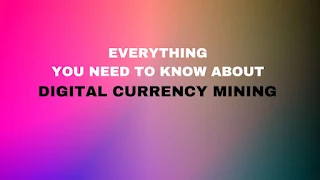Introduction
In the world of cryptocurrencies, digital currency mining is a fundamental process that underpins the security and functionality of blockchain networks. As cryptocurrencies like Bitcoin and Ethereum continue to gain popularity, understanding the intricacies of mining becomes increasingly important. In this comprehensive guide, we will explore everything you need to know about digital currency mining, from the basics of what it is to the technology behind it and how to get started.
What is Digital Currency Mining?
Digital currency mining is the process by which new units of a cryptocurrency are created and transactions are added to the blockchain. Miners use powerful computer hardware to solve complex mathematical puzzles, a process known as proof-of-work. Once a miner successfully solves the puzzle, they add a new block of transactions to the blockchain and are rewarded with a certain amount of the cryptocurrency as a mining reward.
Key Concepts:
1. Blockchain: A decentralized ledger that records all transactions made with a particular cryptocurrency.
2. Proof-of-Work (PoW): A consensus mechanism in which miners must solve mathematical puzzles to validate transactions and add them to the blockchain.
3. Mining Reward: Miners receive cryptocurrency rewards for each block they successfully mine. This includes both newly created coins (block rewards) and transaction fees.
The Technology Behind Mining
To understand digital currency mining, it's essential to grasp the technology that makes it possible:
1. Mining Hardware
Mining hardware includes specialized computer components designed to perform the complex calculations required for mining. These devices range from central processing units (CPUs) to graphics processing units (GPUs), field-programmable gate arrays (FPGAs), and application-specific integrated circuits (ASICs). ASICs are highly efficient and have largely dominated the mining landscape for cryptocurrencies like Bitcoin.
2. Mining Software
Miners use mining software to connect their hardware to the cryptocurrency network. The software helps miners select which cryptocurrency to mine, manages the mining process, and sends mined blocks to the blockchain network.
3. Mining Pools
Mining pools are groups of miners who combine their computational power to increase their chances of successfully mining a block. When a pool successfully mines a block, the rewards are distributed among the participants based on their contributed computational power.
4. Cryptocurrency Wallet
Miners need a cryptocurrency wallet to store the rewards they earn. Wallets can be hardware-based (physical devices) or software-based (applications or online services).
Popular Digital Currencies for Mining
While there are thousands of cryptocurrencies in existence, some of the most popular and widely mined digital currencies include:
1. Bitcoin (BTC)
Bitcoin, the first cryptocurrency ever created, remains the most well-known and widely mined digital currency. Bitcoin mining is highly competitive and often requires significant investment in hardware due to its high computational requirements.
2. Ethereum (ETH)
Ethereum introduced the concept of smart contracts and decentralized applications (DApps). Ethereum mining uses a different algorithm than Bitcoin, and it's possible to mine using consumer-grade GPUs.
3. Litecoin (LTC)
Litecoin is often considered the silver to Bitcoin's gold. It uses a different hashing algorithm called Scrypt, which is memory-intensive and designed to be resistant to ASIC mining.
4. Bitcoin Cash (BCH)
Bitcoin Cash is a fork of Bitcoin and offers faster transaction times. It uses the same SHA-256 proof-of-work algorithm as Bitcoin, making it possible to mine with similar hardware.
Getting Started with Mining
If you're interested in getting started with digital currency mining, here are the essential steps:
1. Choose a Cryptocurrency
Select the cryptocurrency you want to mine based on factors like hardware availability, mining difficulty, and potential profitability.
2. Acquire Mining Hardware
Invest in the appropriate mining hardware, which may include GPUs or ASICs, depending on the chosen cryptocurrency.
3. Install Mining Software
Download and configure mining software compatible with your hardware and the chosen cryptocurrency. Ensure you connect to a mining pool for better chances of earning rewards.
4. Join a Mining Pool
Consider joining a mining pool to combine your mining power with others and receive more consistent payouts.
5. Set Up a Wallet
Set up a cryptocurrency wallet to receive your mining rewards and store your digital assets securely.
6. Monitor and Maintain
Regularly monitor your mining operation, including hardware temperature, power consumption, and mining pool performance. Maintenance and cooling are critical to extending the lifespan of your hardware.
7. Stay Informed
Keep up to date with the latest developments in the cryptocurrency space, including changes in mining algorithms, hardware advancements, and market trends.
Challenges and Considerations
While digital currency mining can be profitable, there are challenges and considerations to keep in mind:
1. Energy Consumption
Mining can be energy-intensive, leading to high electricity costs in some regions. Miners should consider energy efficiency and the environmental impact of their operations.
2. Market Volatility
The value of cryptocurrencies can be highly volatile, impacting the profitability of mining operations.
3. Technological Advancements
The mining landscape is constantly evolving, with new hardware and algorithms emerging. Miners must stay up to date to remain competitive.
4. Regulatory and Legal Issues
Cryptocurrency regulations vary by country, and miners should be aware of their legal obligations and tax implications.
Conclusion
Digital currency mining is a complex but rewarding process that forms the backbone of many blockchain networks. Understanding the technology behind mining, choosing the right cryptocurrency, and staying informed about market trends are essential for success in this space. While mining can be profitable, it also requires careful consideration of factors like energy consumption and regulatory compliance. Whether you're a beginner looking to explore the world of digital currency mining or an experienced miner seeking to optimize your operations, the knowledge and insights provided in this guide will help you navigate the exciting and dynamic landscape of cryptocurrency mining.

